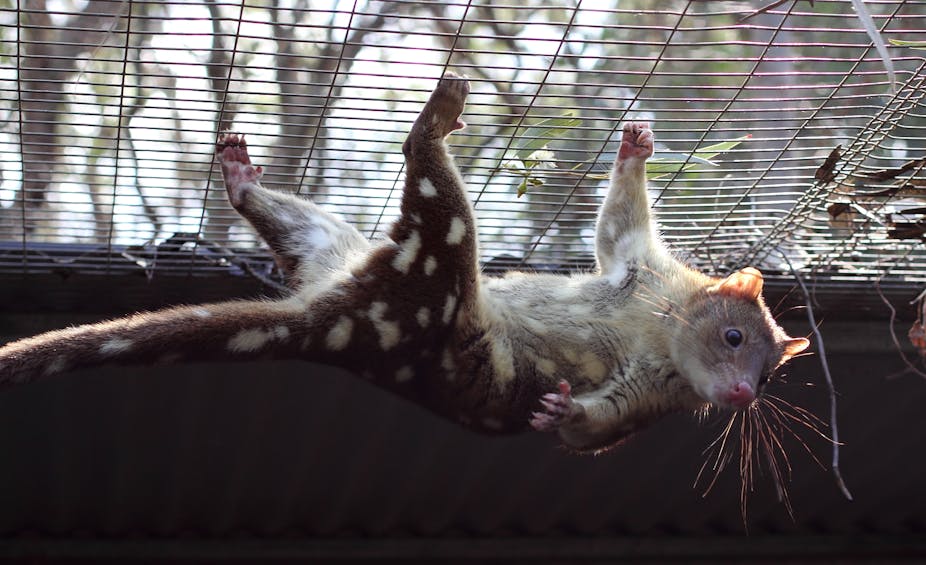Keeping native animals as pets is an idea that’s been around for decades. Notable proponent Professor Mike Archer regards it as a “no-brainer”. Yesterday Senator David Leyonhjelm jumped on the bandwagon by suggesting that Australians choose quolls as alternative pets to cats.
Along with our PhD student Trent Forge and colleague Gerhard Körtner, we study the ecology of spotted-tailed quolls, including their interactions with dingoes, foxes and feral cats, in the high country of northern New South Wales.
Unsurprisingly, we’re big fans of these charismatic native predators. Despite a sometimes fierce appearance, quolls are typically calm, and recaptured animals readily habituate to humans. The right combination of calm quoll and tolerant human (or perhaps vice versa) would conceivably be a great match.
But it might not be so helpful for quolls in the wild.

At the broadest level, we don’t think keeping quolls as companion animals is an especially bad idea.
Further, we’re positively excited about initiatives that would result in Australia reducing the negative environmental impacts of cats.
So what’s the problem? Essentially, we don’t think the Senator’s suggestion is likely to do anything, in practical terms, to address the core problem of wild quolls’ need for active conservation. Ultimately, domesticating quolls is little more than a nice distraction from the bigger issue of conserving these species in a meaningful way.
Good for quolls …
It would be wrong to suggest there are no potential benefits to quolls from “domestication”. Pet status offers quolls the prospect of increased “value” within society and the possibility that people’s contact with them would boost affinity for the species, in turn, making people more likely to support conservation efforts.
However, it’s just as likely that we would see a separation of wild-living and domestic quolls, especially once we focus on selecting individuals with the physical and behavioural traits most appealing to us. Think about the differences between dingoes and some popular domestic dogs. “Teacup” quoll, anyone?
Such partitioning of the species would have the real-world impact of improving our understanding of their biology but not necessarily their ecology.
Take the example of tigers (Panthera tigris) as pets – the number of tigers as domestic pets rivals the world population of wild tigers – nearly 3,000 individual tigers are pets in the United States alone, yet this does nothing for conservation of wild tigers, populations of which are slipping away.
As would no doubt happen with domestic quolls, domestic tigers are subject to strong genetic manipulation to yield oddities like white tigers and the “golden tabby” that have no value to conservation of the species even if they were the last tigers in existence.
… but not quolls in the wild
We want to recognise Senator Leyonhjelm’s good intentions: with quolls as pets, it’s highly unlikely that quolls would become yet another extinct Australian animal.
Total extinction is the worst case scenario. However we should be trying just as hard to avoid quolls becoming extinct in the wild. Indeed, we worry that focusing too heavily on domestication-as-insurance may have the perverse effect of shifting attention away from the urgent need for active conservation.
If quolls are perceived as being secure, why would we spend money trying to keep them in the wild?
At this point in time, we are still buoyed by the fact that some parts of mainland Australia appear to have apparently healthy populations of spotted-tailed quolls. We are further encouraged by efforts to understand, protect and promote our other quoll species.

Quolls threatened
At our study sites, including those in Oxley Wild Rivers, Werrikimbe and New England National Parks, it is possible to see and study quolls in “good numbers”.
However, within the same landscape there is growing evidence of quoll decline, especially associated with core habitat loss, declining connectivity, and negative impacts from invasive predators.
Loss of habitat in and around conservation areas is reducing the functional conservation footprint for species such as quolls. Using GPS-collars, we often record quolls moving outside the conservation areas where they have been trapped.
Each foray represents an opportunity for quolls to expand their local distribution but they are often faced with sparsely vegetated and narrow corridors amid a sea of foxes and feral cats. Their prospects for survival in this type of environment are often poor.
These problems are reversible. We must not continue to knockdown old trees, not windrow and burn dead timber and we can and must actively control red foxes. Feral cats are more difficult but not impossible to manage.
Rather than focusing solely on quolls as a new pet we encourage Senator Leyonhjelm and all Australians to at least also support active conservation of quolls.
Otherwise, in the near future we might have them in our houses but not in the wild.

